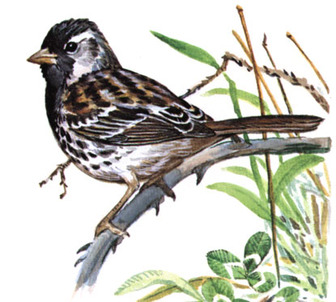Harris' sparrow
Their breeding habitat is the north part of central Canada . In fact, this bird is Canada's only endemic breeder. In the winter they migrate to the Great Plains states of the United States, from lower South Dakota to upper Texas.

The Harris' sparrow is classified as Least Concern. Does not qualify for a more at risk category. Widespread and abundant taxa are included in this category.
in Harris' sparrows and white-crowned sparrows in the Northwest Territories, Canada. Auk. vol 110, no 4. p. 769-777. * Norment CJ. (1994). Breeding site fidelity in Harris' Sparrows, Zonotrichia querula, in the Northwest Territories. Canadian Field Naturalist. vol 108, no 2. p. 234-236. * Norment CJ. (1995). Incubation patterns in Harris' Sparrows and White-Crowned Sparrows in the Northwest Territories, Canada. More
1992 to request data on Harris' Sparrows for a 4-H Club project. Her report and poster display won top honors at the Tri-Rivers Fair in Salina, Kansas, and she was cited nationally by 4-H for excellence in the study of "Conservation of Wildlife and Natural Resources." The Harris' Sparrow is a common bird at our feeders every year. It has an orangeish bill, a black face, black crown, and streaked sides. It feeds on the ground and likes seeds and some insects. More
From its earliest history Harris' Sparrow has been surrounded by an aura of excitement and drama. Because its distribution is restricted to the center of the continent, not until 1834 did the eager eyes of science view it for the first time. Harry Harris (1919) relates in fascinating detail how two separate parties of explorers discovered the species within two weeks and a few miles of one another. On an expedition headed westward across Missouri with John K. More

Original source: Jason Weckstein
Author: Jason Weckstein
Permission: Some rights reserved
Family : Emberizidae
Genus : Zonotrichia
Species : querula
Authority : (Nuttall, 1840)
